Dates Of Visit: July 8, 2017 & July 15, 2017
Location: 1040 MASS MoCA WAY, North Adams, MA
Hours:
Fall/Winter/Spring Hours
11am–5pm, closed Tuesdays
Open January 1, 2018
Fall/Winter/Spring Tours
Wed.-Mon.: Two museum highlights tours: B6: The Robert W. Wilson Building and Buildings 4, 5, and 7 at 2pm
Summer Hours (begin June 2018)
10am—6pm Sundays—Wednesdays
10am—7pm Thursdays—Saturdays
Cost:
Admission
Adults $20
Seniors / Veterans $18
Students with ID $12
Kids (6–16) $8
EBT/WIC Cardholder $2
They also offer 2 day and 3 day admission tickets
Parking: There are four parking lots in the museum parking area
Handicapped Accessible: Yes
Website: MASS MoCA

As I was looking through my photos from last year, I came across some photos I took at MASS MoCA last summer. Since there are so many photos of many different exhibits, I am planning on posting my photos in several parts. I hope you enjoy this trip through the many art works and creative exhibits at this very unique museum.
Once the site of a factory building complex, MASS MoCA (Massachusetts Museum of Contemporary Art) is now home to a variety of art from a variety of artists and styles.
Formerly the Arnold Print Building which operated there from 1860 to 1942 and the Sprague Electric Company, MASS MoCA consists of several buildings, some of which are connected by bridges and walk ways.
MASS MoCA has both permanent exhibits (or at least semi permanent exhibits) as well as many temporary exhibits.
Decorated walls are a constant theme at the museum. One of the permanent exhibits on display at the museum are these walls with stylized designs on them.
This work of art by Barbara Takenaga called Nebraska (2015) is composed of acrylic on digitally printed wallpaper. The wallpaper was translated from her handcrafted easel work. The 120 foot mural represents the open plain of Nebraska, Takenaga’s home state. The design is meant to represent the corn and stars that are evident on an evening in her home state. The work of art is meant to show the “blue hour” when the earth and sky begin to merge.
On the second floor of the museum, there are several walls with different designs painted on them.
The following art is part of Sol Lewitt’s A Wall Drawing Retro-spective exhibit.
This exhibit comprises 105 of LeWitt’s large-scale wall drawings, spanning the artist’s career from 1969 to 2007. These works of art take up nearly an acre of specially built interior walls that have been installed, per LeWitt’s own specification. They span over three stories of a historic mill building situated at the heart of MASS MoCA’s campus. The 27,000-square-foot structure, known as Building #7, has been fully restored for the exhibition by Bruner/Cott & Associates architects.
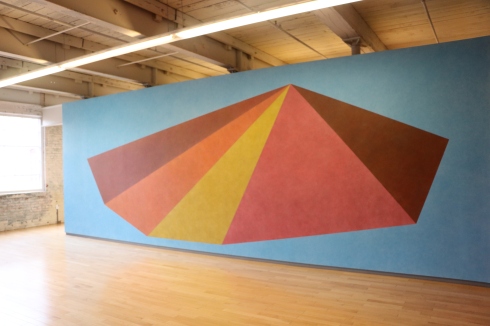
“Wall Drawing 439” – May, 1985, asymmetrical pyramid with color ink washes superimposed. Color ink wash.
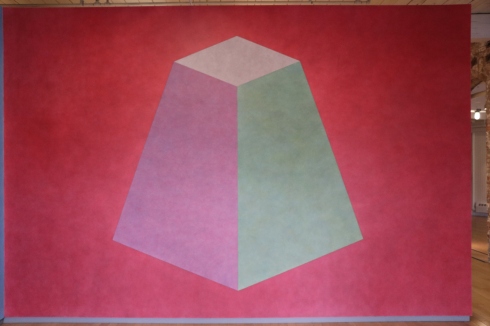
“Wall Drawing 527” – April, 1987, two flat-topped pyramids with color ink washes superimposed. Color ink wash.

From left to right: “Wall Drawing 583H” : rectangles with color ink washes superimposed. Each is bordered by a 10-inch band with color ink washes superimposed, a 1/2 inch white band and a 4 inch black band – color ink wash, December, 1988
Center: “Wall Drawing 584 H”: squares, divided horizontally and vertically into four equal parts. Within each part, color ink washes superimposed. The squares are bordered by a 1/2 inch white band and a 4 inch black band – color ink wash, January, 1989
Right: “Wall Drawing 583F”” rectangles, with color ink washes superimposed. Each is bordered by a 10 inch band with color ink washes superimposed, a 1/2 inch white band and a 4 inch black band – color ink wash, December, 1988

In the far right corner of this display by itself is “Wall Drawing 725” – On a blue wall, a black square within a white border. India ink, color ink wash, gouache. April, 1993.
“Wall Drawing 343 A-F”: On a black wall, nine geometric figures (including right triangle, cross, X) in squares. The backgrounds are filled in solid white.
December 1980
White crayon on black wall
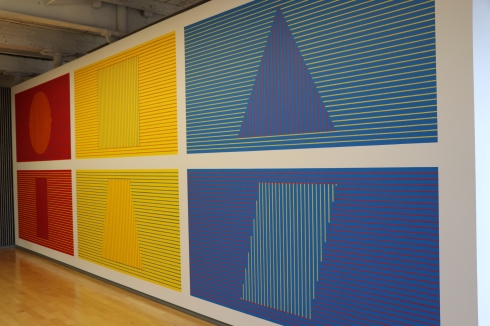
“Wall Drawing 340”
Six-part drawing. The wall is divided horizontally and vertically into six equal parts. 1st part: On red, blue horizontal parallel lines, and in the center, a circle within which are yellow vertical parallel lines; 2nd part: On yellow, red horizontal parallel lines, and in the center, a square within which are blue vertical parallel lines; 3rd part: On blue, yellow horizontal parallel lines, and in the center, a triangle within which are red vertical parallel lines; 4th part: On red, yellow horizontal parallel lines, and in the center, a rectangle within which are blue vertical parallel lines; 5th part: On yellow, blue horizontal parallel lines, and in the center, a trapezoid within which are red vertical parallel lines; 6th part: On blue, red horizontal parallel lines, and in the center, a parallelogram within which are yellow vertical parallel lines. The horizontal lines do not enter the figures.
July 1980
Red, yellow, blue crayon on red, yellow and blue wall
“Wall Drawing 335”:
On four black walls, white vertical parallel lines, and in the center of the walls, eight geometric figures (including cross, X) within which are white horizontal parallel lines. The vertical lines do not enter the figures.
May 1980
White crayon on black wall
I found myself mesmerized by these works of art. It seemed like the colors and shapes were busy, as if staring at some of them too long can give you a headache. Yet, I couldn’t stop looking at them. Some of them, especially the lines on the wall with the circles and rectangles on the grey wall seemed to change shapes and direction based on which direction you looked at it from.
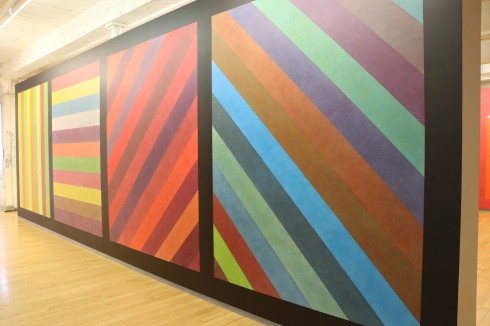
“Wall Drawing 681C”: a wall divided vertically into four equal squares separated and bordered by black bands. Within each square bands in one of four bands in one of four directions each with color ink superimposed. Color ink wash, August, 1993
“Wall Drawing 414”
Drawing Series IV (A) with India ink washes. (24 Drawings.)
March 1984
India ink wash
“Wall Drawing 391”
Two-part drawing. The two walls are each divided horizontally and vertically into four equal parts. First wall: 12-inch (30 cm) bands of lines in four directions, one direction in each part, drawn in black India ink. Second wall: Same, but with four colors drawn in India ink and color ink washes.
April 1983
India ink and color ink wash
I especially liked how the walls were displayed throughout the room. The aisles between the walls made for good photo opportunities.
Across from “Wall Drawing 414” was the color version of the same work of art
“Wall Drawing 413”
Drawing Series IV (A) with color ink washes. (24 drawings.)
March 1984
Color ink wash

“Wall Drawing 692”
Continuous forms with color ink washes superimposed.
October 1991
Color ink wash
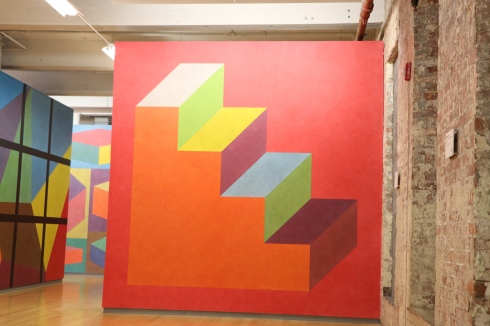
“Wall Drawing 610”
Isometric figure with color ink washes superimposed.
June 1989
Color ink wash
“Wall Drawing 422”
The room (or wall) is divided vertically into fifteen parts. All one-, two-, three-, and four-part combinations of four colors, using color ink washes.
November 1984
Color ink wash
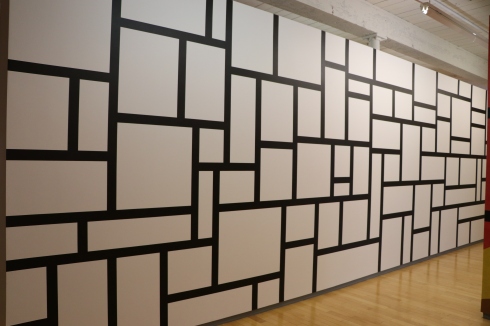
“Wall Drawing 614”
Rectangles formed by 3-inch (8 cm) wide India ink bands, meeting at right angles.
July 1989
India ink
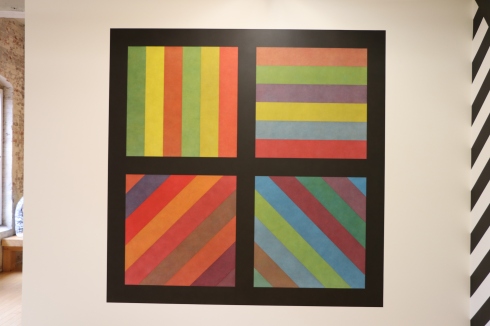
“Wall Drawing 684A”
Squares bordered and divided horizontally and vertically into four equal squares, each with bands in one of four directions.
June 1999
Color ink wash

“Wall Drawing 630” & “Wall Drawing 631”
“Wall Drawing 630”
A wall is divided horizontally into two equal parts. Top: alternating horizontal black and white 8-inch (20 cm) bands. Bottom: alternating vertical black and white 8-inch (20 cm) bands.
January 1990
India ink
“Wall Drawing 631”
A wall is divided into two equal parts by a line drawn from corner to corner. Left: alternating diagonal black and white 8-inch (20 cm) bands from the lower left. Right: alternating diagonal black and white 8-inch (20 cm) bands from the upper right.
January 1990
India ink

“Wall Drawing 766”
Twenty-one isometric cubes of varying sizes, each with color ink washes superimposed.
September 1994
Color ink wash
“Wall Drawing 415D”
Double Drawing. Right: Isometric Figure (Cube) with progressively darker graduations of gray on each of three planes; Left: Isometric figure with red, yellow, and blue superimposed progressively on each of the three planes. The background is gray.
March 1993
Color ink wash

“Wall Drawing 522D” (to the right in the photo)
Tilted forms with color ink washes superimposed.
December 1987
Color ink wash
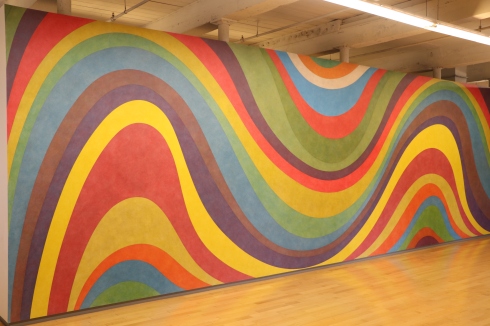
“Wall Drawing 793B”
Irregular wavy color bands.
January 1996
Color ink wash
“Wall Drawing 792”
Black rectangles and squares.
June 1995
Dispersion paint

“Wall Drawing 579”
Three concentric arches. The outside one is blue; the middle red; and the inside one is yellow.
November 1988
Color ink wash
“Wall Drawing 766”
Twenty-one isometric cubes of varying sizes, each with color ink washes superimposed.
September 1994
Color ink wash
“Wall Drawing 386”
Stars with three, four, five, six, seven, eight, and nine points, drawn with a light tone India ink wash inside, an India ink wash outside, separated by a 6-inch (15 cm) white band.
January 1983
India ink wash
Based on the museum’s website, there appears to be many more walls with Lewitt’s work on them in the building, many of which seem to have been added since my visit.
Cosmic Latte is an exhibit designed by famed artist Seymour Finch. The 350 lights are meant to represent a constellation. The name Cosmic Latte refers to the official name given to the color of our universe. A 2009 study of the light emitted by 200,000 galaxies proved the light of our universe is more of a beige color than the blue color it is usually described. The spacing of the fixtures is meant to model the atomic of powdered pigments that Finch used to emulate the specific Cosmic Latte color. He used the following colors to achieve this Cosmic Latte hue: titanium white, Mars Yellow, chrome yellow and cadium red.
The fixtures are arranged in a similar pattern to that of the Milky Way as it is observed in the Northern Hemisphere in March. The undulating swathe of the lights relates to the nearby Hoosic River which is visible through the windows.
Art is everywhere at MASS MoCA. These benches with cubby hole storage were located just outside of Kidland, where the Cavernous display was located.
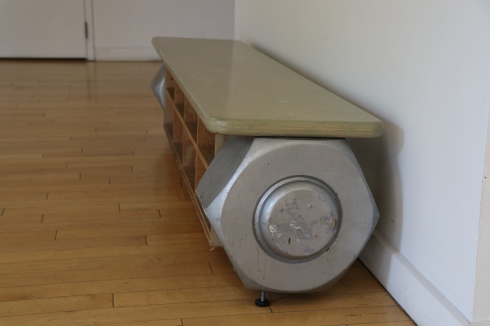
During my visit, there was a special, temporary exhibit on display for children. Inspired by the Hoosac Tunnel which, in 1974, was built to be part of a rail system that connects Albany NY to Boston, MA, Cavernous: The Inner Life of Courage is an interactive work of art in which visitors can walk inside and play inside. The exhibit is meant to teach visitors what it takes to be courageous and persevere in the face of mountain-sized obstacles. Visitors are invited to play in a tunnel-like structure built specifically for the museum. Designs and words are written on the floors and walls. There are also cushioned seating for children to sit on inside the work of art. Good luck getting the kiddies to leave!
Children and other visitors were encouraged to leave little notes in the cavern.
The tunnel system that was built was meant to be a metaphor for courage.
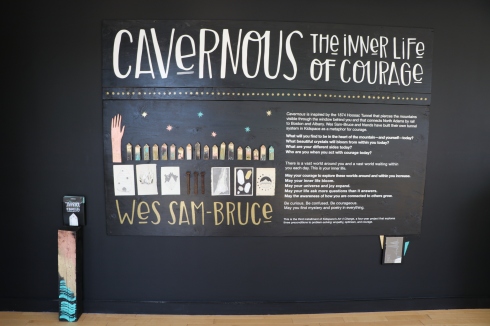
This exhibit was part of the Kidspace area of the museum.
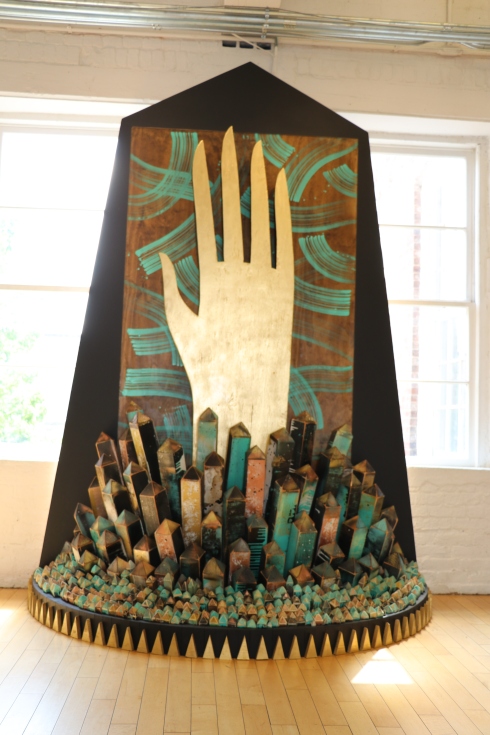
This is part one of a multiple series post. I am not sure how many posts will be involved in the MASS MoCA serries. But, stayed tuned for more creative works of art!
Below are some videos of the work involved in creating some of the art at MASS MoCA












































January 6th, 2018 at 3:24 am
Happy 2018 again!
Hope the deep freeze don’t dampen your gusto to get out there!
LikeLiked by 2 people
January 6th, 2018 at 6:32 pm
Happy new year to you both as well! Pfft, we don’t let a little cold weather stop us in New England ( :
LikeLiked by 1 person
January 6th, 2018 at 6:35 am
Fascinating! Thanks for linking the “making of” videos. They educate in their own way.
LikeLiked by 2 people
January 6th, 2018 at 6:31 pm
Yes, I loved seeing how they are all made as well! It’s very interesting and quite an undertaking.
LikeLike
January 8th, 2018 at 1:23 am
I was there recently and still missed some of this stuff – it’s a big place
LikeLiked by 2 people
January 9th, 2018 at 10:06 am
It is huge! That is why buying a 2 day pass, if you’re staying in the area or if you live near the museum, is such a good idea. Thank you.
LikeLike
January 11th, 2018 at 3:50 pm
Hi Wayne, Great post! We’ll definitely have to check this place out next time we’re up North! Hoping to pick your brain for an article I’m writing. Would you mind emailing me?
LikeLiked by 2 people
January 13th, 2018 at 12:23 am
Thank you, Phoenix. Sure, I will be in touch.
LikeLike